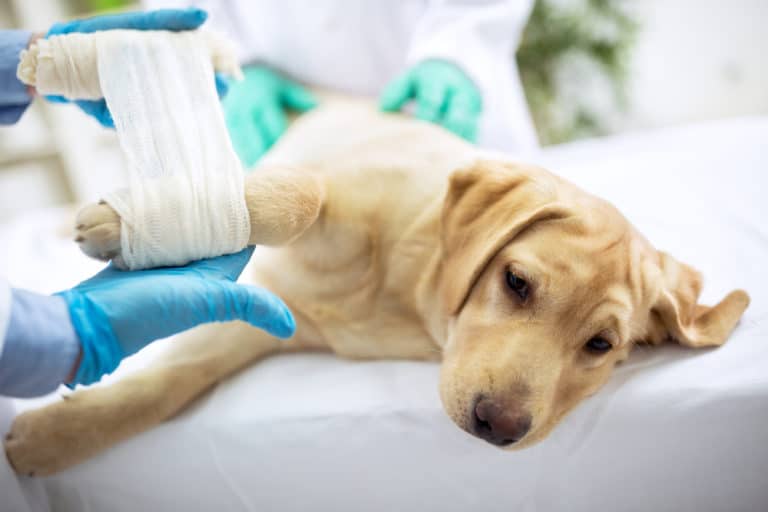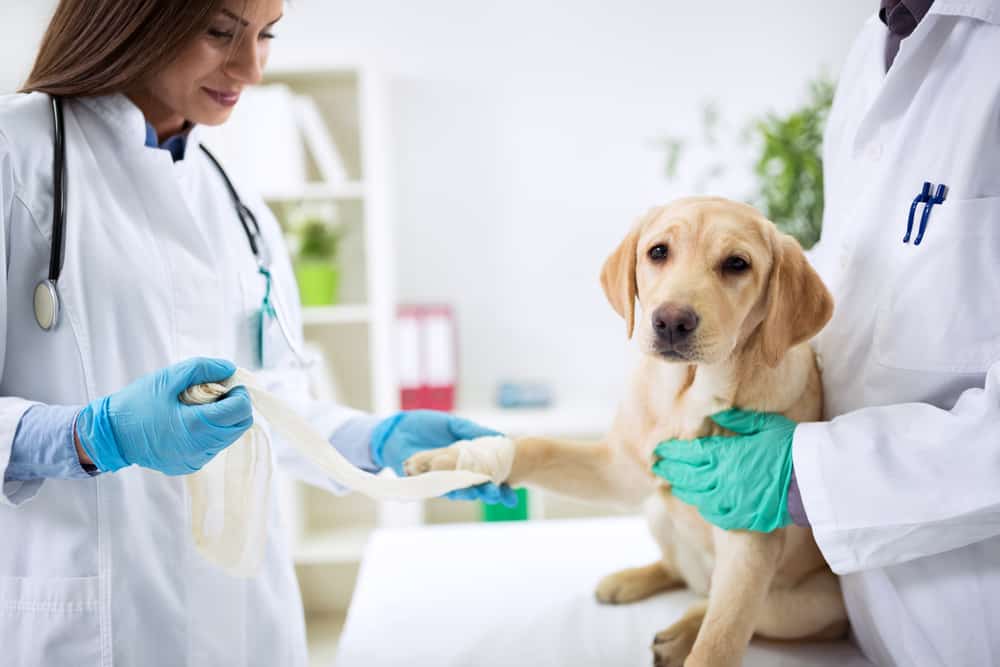
Few things are as stress-inducing as a new pet owner as watching your suffer from a .
Unfortunately, it’s not at all uncommon for young dogs (even puppies that are just a few months old) to suffer from broken bones, fractures, and serious emergencies that need ASAP.
Our furry little family members like to get themselves into sticky situations all the time. Accidents happen, limbs get twisted and broken, and all of a sudden our is and favoring one side or another.
In these moments, it’s critically important that you get your the right care as quickly as possible.
You need to find a that can correctly set a puppies bones that have been or broken, but you also need to follow their instructions for home care to the letter as well.
The last thing you want is for the set or to go well and the follow-on care to go poorly, forcing your to live the rest of their lives with a limp and significant .
Luckily, with the help of this quick guide – and the express instructions provided to you from your – you won’t have to worry about that!
Let’s begin, shall we?
It All Starts with Pet Triage Care Following the

Right out of the gate, the moment that you notice your is or your pet behaving as though they have been , it’s important to triage the situation until you can get to your .
The last thing you want to do is panic, get all excited, and cause them to stress and worry. Your is already in plenty of in the last thing you want to do is exacerbate the situation by sending out energy and body language that’s only going to make things worse.
No, instead you need to simply triage the situation quickly and effectively. That’s generally going to involve:
Diagnose the – Assessing the situation, inspecting the injured area, and determining that you are dealing with broken bones in the first place. It’s not uncommon for dogs to limp when they are young just because they wore out their muscles, have a cramp, or have a significant bump or bruise.
Performing Pet First Aid – Pay attention to how your is breathing, whether or not they are alert, and what their pulse situation is like. The overwhelming majority of break situations are not going to be life-threatening, but you want to be sure that this isn’t compounded with other problems, too.
Physically Examine the – This is where you’re going to want to gently touch and hold the or the knee of your pet, feeling for obvious signs of and trauma (like swelling, for example). Be very careful here and do not try to over manipulate the bone or the joints of your dog. You’re just trying to get a feel for things (no pun intended).
Injuries – After you have gotten a better feel for what’s happening and the that your is dealing with, it’s time to the injuries (whenever possible) – especially if there is blood. Go lightly, be careful, and don’t apply a lot of extra pressure with bandages, particularly to and situations.
A splint or Sling Your Dog – The last bit of triage you’re going to want to do as a pet owner before you bring your to the is to either or sling your furry little addition to the family. Both of these approaches immobilize situations a bit, help to prevent a bad situation from getting worse, and eliminate a lot of the and stress your dogs would have been dealing with walking around on a busted .
Now it’s time to get to the ASAP!
If you aren’t going to be able to physically sit in the back of the vehicle with your dogs suffering from a (mostly so that you can calm them down, comfort them, and restrain them from moving around) it’s not a bad idea to slide them into a carrier with some towels or a bed to lay on.
The important thing here is to immobilize the as much as possible before you get to the . You really want to minimize the potential for an already bad break to get worse.
Follow Instructions From the Veterinary Surgeon to the Letter

Depending on the specific or a that your is dealing with there are a variety of different ways that a can set the problem and begin the healing process.
You’re going to want to defer to their medical experience (obviously) but sitting in the lobby or the waiting room while your pet is being worked on is never fun and never easy.
Still, provided you have chosen the right location (picked a you know you can trust, a that came highly recommended) you don’t have much to worry about.
Your furry little family member will come out from this experience in a or cast in much better condition, and you’ll be able to get them down the road to recovery much faster by listening to the follow-on care instructions provided by your , too.
Now, every is going to have different ideas about how dogs recover faster from broken bones. But the overwhelming majority of them are going to recommend similar core principles that we highlight below.
1. Plenty of Rest
Every is going to recommend that your get plenty of rest when they are dealing with broken bones or a broken knee/.
The odds are pretty good that your is going to come out of the different treatment options on at least a little bit of , which makes helping your rest that first day pretty easy.
After that, though, you’ll want to make sure that your isn’t leading the rambunctious, action-packed life young dogs like to live – the kind of rambunctious, action-packed life that potentially caused this break or in the first place.
Use meds as directed to help them get the rest they need right away, but also invest in high-quality bedding that they can find their way into easily to rest more comfortably, too
2. Keep the Dry
Secondly, you’re going to make sure that you are keeping the or as dry as possible – especially when the has been put in a cast or a sling.
Keeping the injured dry is going to help speed up their healing . Make sure that the medical dressings are dry, any blood or puss is cleaned away as quickly as possible, and that any splints are swapped out as necessary, too.
3. Prevent Your Pup from Licking the
Every has a mouth filled with bacteria, and that’s the last thing you want swimming around busted bones, fractures, or a compromised recovering from .
Chances are good that your is going to provide you with cones for dogs that slip over their head for the specific purpose of keeping your from licking the location of the .
You might want to invest in a higher quality cone than the one you get straight from the clinic, but you want to keep them from licking the area of the is much as possible to prevent infection.
4. Restrict Movement for a Month
Keeping your dogs activity level low for the first month is another big piece of the puzzle to helping them heal as quickly as possible.
Doing this with furry little family members loaded with energy is never easy, but it’s the only way to prevent an accident that can cause more fractures, more damage, or more fragments to pop up – restarting the healing journey all over again.
No, it’s a good idea to try and keep canine fractures immobilized for at least 30 days (at least as much as you can).
Five-minute walks throughout the day and bathroom breaks help to keep the muscles working and the bones to heal faster without having to worry about making the severity of the even worse.
5. Be Smart and Stick to a Schedule with Meds
Any that breaks and any is going to cause a lot of , not just in the instant that the accident or happened but during the healing process as well.
Following (no matter the type of treatment method prescribed) is going to be a big asset in helping your recover faster.
With these medications and options, though, you need to be sure that you are only ever giving the recommended dosage and not even just a little bit more.
In fact, it’s not a bad idea to dial back the dosage (at least at first) to see with the individual user experience for your will be.
Be smart about using these medications and stick to a consistent schedule and you won’t have much to worry about.
6. Schedule a Six Week Follow Up for Your
Following any break or (or fractures, for that matter) it’s a good idea to schedule a six-week follow-up for your – especially if you have the pet insurance to cover this kind of checkup, too.
Your will be able to better track the progress of your following the surgeries they’ve gone through. They will usually recommend x-rays just to check and see what’s happening “under the hood”, confirming that the severity of the situation has reduced significantly.
This is also usually when vets will start to recommend anti-inflammatories if necessary, different types of , or any future that may be necessary to readjust a or fragile that isn’t healing the way it should be.
All in all, this is an important part to make sure that the healing is unfolding the way that it should be and that your is going to be able to lead a happy, healthy, active lifestyle moving forward for sure.
FAQ
How Long Does It Take for a ‘s to Heal??
All animals heal differently (just like all bones that break heal differently – the humerus, the radius, and the femur all healing on different schedules), but the majority of canine fractures are going to heal and anywhere between four weeks and eight weeks or so.
Can a Pup Walk on a Broken ?
Usually, young dogs are going to be able to walk around on a or a if they absolutely must, but it’s not the best idea. You want to immobilize this as quickly as possible and get them to a as soon as you can.
Can a ‘s Heal on Its Own?
Sure, it’s possible for different types of to heal all on their own – but you are taking a risk with this approach.
Pets throughout time (way before pet insurance ever existed) have had issues and problems that heal on their own. But those same animals that heal without inevitably walk with a limp and suffer a lot more than necessary.
How Do You Tell If a Has a ?
, swelling, your being unable to put any weight down on a specific , heavy breathing, a lack of exercise, no real interest in play time, or legs that just don’t seem to want to “behave” are all signs of a in our pets you’ll want to be on the lookout for.